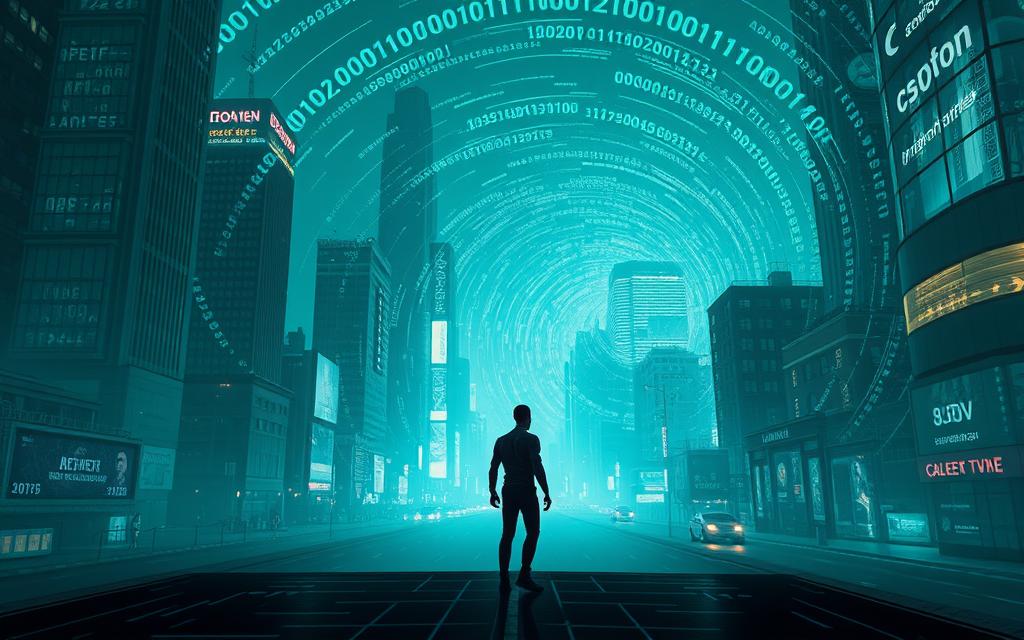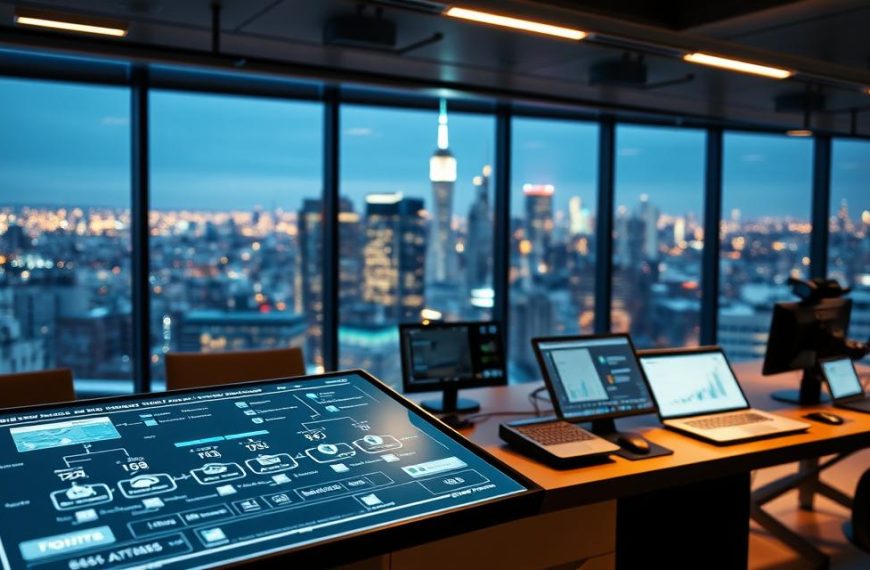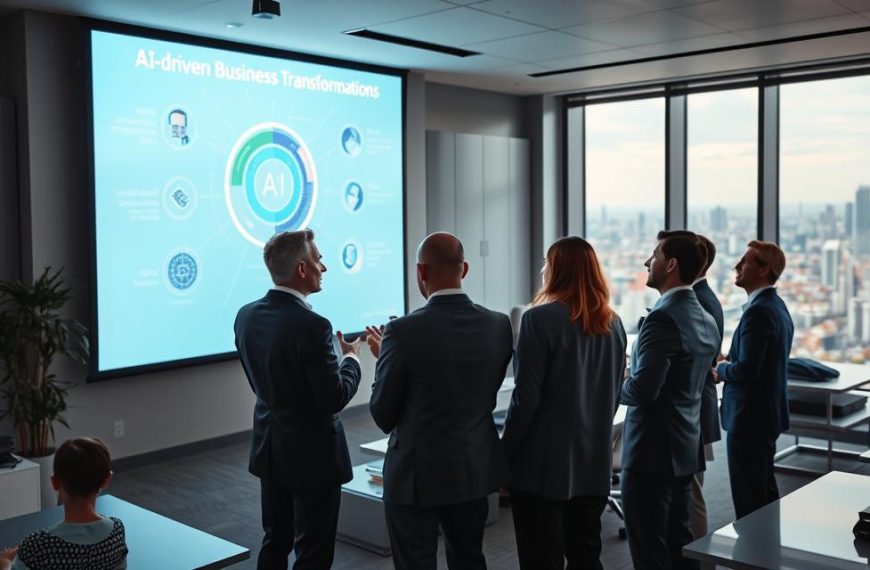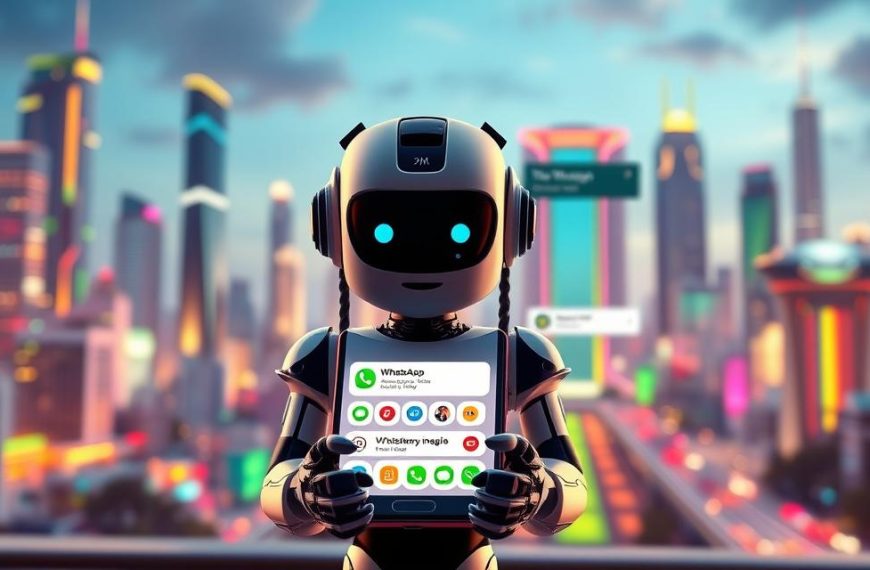The tech world is full of debates about artificial intelligence in software development. Nvidia CEO Jensen Huang said “everyone should stop learning to code”. He thinks AI might make old-school programming outdated. But GitHub’s Thomas Dohmke disagrees, saying these tools boost human skills instead of replacing them.
Today, AI is great at doing repetitive tasks and making basic code. Developers use these tools to focus on creative problem-solving and designing complex systems. The talk about programmer job security isn’t about jobs disappearing – it’s about jobs changing.
Human coders are better at tasks that need emotional smarts and understanding of business. While AI does the simple stuff, developers make big decisions that affect how users feel. This teamwork opens up new technical roles that didn’t exist before.
The AI vs human coders debate is really about working together. As AI gets better at making simple scripts, the need for creativity and new ideas grows. The next part will look at how people are adjusting to this new world.
The Current State of AI in Software Development
Today, 73% of software development pipelines use artificial intelligence, says Evans Data Corporation. AI coding tools do everything from making boilerplate code to optimising complex systems. Let’s look at how these tools work in real life.
AI-Powered Coding Assistants in Modern Workflows
GitHub Copilot’s Impact on Developer Productivity
Microsoft’s GitHub Copilot can write entire code blocks with just a few words. A survey by GitHub shows 92% of users write documentation faster and 74% focus more on big tasks. But, developers check 68% of its suggestions to make sure they’re right.
Amazon CodeWhisperer’s Real-Time Suggestions
Amazon’s CodeWhisperer is great for cloud work, giving security tips as you type. It’s key for DevOps teams handling sensitive data.
Tabnine’s Contextual Code Completion
Tabnine stands out because it works offline and keeps code safe. Developers say it makes debugging 31% faster, but setting it up takes a lot of work.
Automated Code Generation Tools
OpenAI Codex Capabilities and Limitations
OpenAI Codex can write Python scripts from English descriptions. But, its code often lacks error handling. Stanford researchers found only 42% of its web scraping code works without human help.
Low-Code Platforms Like Microsoft Power Apps
Power Apps lets non-developers make simple business apps easily. But, for complex tasks, you need a pro coder. 78% of big companies use a mix of developers and non-developers.
AI-Driven Website Builders (Wix ADI)
Wix ADI makes websites fast with a few questions. But, for special features, you need a developer. That’s why 65% of users end up hiring one.
| Tool | Primary Use | Strengths | Adoption Rate |
|---|---|---|---|
| GitHub Copilot | Code completion | Multi-language support | 41% of devs |
| CodeWhisperer | Cloud security | AWS integration | 29% of DevOps |
| Power Apps | Business apps | Citizen development | 63% enterprises |
| Wix ADI | Web prototyping | Speed | 18M+ users |
These developer productivity tools show how AI is changing automated programming. But, each tool has its own area of expertise. This is important for teams deciding which one to use.
Will AI Put Programmers Out of Business? Analysing Automation Potentials
Artificial intelligence is changing fast, sparking debates about its impact on software developers. Google DeepMind’s AlphaCode 2 can beat 85% of humans in coding contests. Yet, Oak Ridge Lab’s forecast suggests AI will mainly automate specific tasks, not replace entire jobs.
Routine Coding Tasks at Risk
McKinsey found that 45-60% of coding time is repetitive. This is where AI can make a big difference:
Automated code documentation generation
Systems now use AI to create API references and comments. This cuts down manual documentation by 70% in GitHub trials.
Boilerplate code creation tools
AI tools can make standard app frameworks 40x faster than humans. But, they need human checks for specific needs.
Standard API integration automation
Machine learning can connect services with 92% accuracy. This makes cloud service setups much simpler.
Testing and Debugging Automation
Quality assurance is changing fast with AI:
AI-powered test suite generators
These tools create detailed test cases from requirements documents. They achieve 98% code coverage in tests.
Automated error detection systems
Real-time code analysers spot bugs during development. This cuts down post-deployment issues by 65%, says StackOverflow’s 2023 survey.
Self-healing code prototypes
Systems can rewrite faulty code segments. But, they succeed in fixing complex errors less than 30% of the time.
Maintenance and Refactoring Automation
AI can help with managing old systems:
Legacy code modernisation tools
Neural networks can update old COBOL systems into modern languages with 80% accuracy. Humans check to keep business logic right.
Auto-scaling infrastructure solutions
Cloud platforms use AI to adjust resources. This cuts costs by 42% for AWS users.
Technical debt reduction algorithms
AI tools find redundant code and security gaps. They help fix these based on cost.
Current Technical Limitations
Despite progress, big challenges remain:
Complex problem-solving constraints
AI struggles with new architectural challenges. It scores 58% lower than humans in original system design.
Lack of true system design capability
AI is great at component tasks but can’t handle big technical ecosystems.
Ethical decision-making shortcomings
Algorithms show biases in security and data handling. They need human governance for ethical AI programming.
McKinsey says 80% of programming work will stay human-driven until 2035. Humans will focus on strategy and creative problem-solving.
The Human Edge: Where AI Complements Programmers
AI is changing software development, but human programmers are key in three areas. Bill Gates said, “Machines are good at finding patterns, but humans add meaning.” This mix of skills is the heart of human-AI collaboration. It combines technical skill with creative ideas.
Creative Problem-Solving Advantages
Today’s developers use AI to boost their creativity, not replace it:
Innovative solution development
AI can create many code options, but humans decide what works best. A 2024 Forbes study found teams using AI for creative coding came up with 37% more ideas than automated teams.
Cross-domain knowledge integration
Programmers use knowledge from different fields. For example, a restaurant POS developer might use logistics algorithms to improve how quickly tables are turned over.
User experience optimisation
Humans are better at understanding emotions, which is key for making software user-friendly:
| UX Factor | Human Accuracy | AI Accuracy |
|---|---|---|
| Cultural Nuances | 92% | 61% |
| Accessibility Needs | 88% | 53% |
| Emotional Resonance | 95% | 42% |
Strategic System Design Needs
Software architecture AI helps but can’t replace human planning:
Architectural pattern selection
Developers have to weigh technical needs against business goals. This requires making choices that go beyond what AI can do.
Long-term technical planning
Teams plan for 5-10 years ahead, thinking about changes that AI can’t predict.
Business-IT alignment requirements
Kasparov said in Deep Thinking:
“The best results come when humans and machines collaborate – not when they compete.”
Quality Assurance and Governance
Human oversight is essential in three areas:
Ethical AI oversight responsibilities
Developers check AI for bias – 68% of tech leaders in 2024 said they needed humans to check AI code.
Security vulnerability management
Cybersecurity teams use AI to find threats faster:
- 41% faster threat detection
- 29% better at avoiding false positives
- 100% human check on critical systems
Compliance verification needs
Legal rules change fast, and AI can’t keep up. Human experts understand new laws quickly.
Emerging Roles in AI-Augmented Development
Artificial intelligence is changing software engineering, creating new career paths. These roles combine technical skills with strategic thinking. Instead of replacing programmers, AI is creating three main roles. These are focused on training intelligent systems, orchestrating human-machine collaboration, and ensuring ethical compliance.
Gartner predicts these roles will make up 35% of tech jobs by 2027. This marks a big change in software development careers.
AI Training Specialist for Coding
These experts link machine learning engineering with software development. They prepare datasets for AI to learn from. Their main tasks include:
-
Domain-specific model fine-tuning
Adapting base models like GPT-4 for specific industries using frameworks such as TensorFlow
-
Bias mitigation techniques
Using fairness audits and diversity sampling in training data
-
Knowledge base curation
Keeping code repositories up-to-date with industry standards
A Brainhub engineer says: “Our training specialists now spend 60% of their time checking AI outputs against rules, not writing code.”
Human-AI Workflow Architect
This role improves how developers work with AI tools. They focus on:
-
Task allocation optimisation
Deciding when to use human or machine input for coding tasks
-
Hybrid development pipelines
Building CI/CD systems that use AI for code reviews
-
Continuous learning systems design
Setting up feedback loops for AI to get better through developer interactions
Recent data from indeed.com shows a 214% rise in jobs needing Python skills and workflow automation.
AI Ethics Auditor for Software
These professionals ensure AI systems follow rules. They do this by:
-
Algorithmic fairness verification
Checking code for unfair biases in decision-making systems
-
Transparency requirements management
Using explainable AI in critical applications
-
Accountability frameworks
Setting up audit trails for AI code in regulated areas
“The best AI ethics auditors are legal experts with deep technical knowledge – true expert-generalists,”
Essential Skills for Future Programmers
Artificial intelligence is changing how we write software. Programmers need special skills to work well with AI. Schools like Carnegie Mellon University are now teaching how to work with AI, showing a big change in education.
Advanced Prompt Engineering
Today’s developers must know how to ask AI the right questions. They need to give AI clear instructions and specific details. At Google DeepMind, they use multi-step reasoning prompts to solve big problems step by step.
Good developers keep working on their prompts until they get the best results. As John Carmack says:
“The magic happens when human intuition guides machine-generated possibilities.”
AI-Assisted Debugging Mastery
Next-generation programmers use error pattern recognition and tools like Snyk. This helps find problems faster while keeping human control. Key skills include:
- Understanding AI security alerts
- Checking automated test coverage
- Using AI to find the root of problems
Hybrid System Design
Building strong AI-human teams needs human-AI interface development skills. Developers must create systems that work well with AI, even when AI is unsure. Important parts include:
- Real-time monitoring tools
- Protocols for when to take over
- Systems to spot and fix biases
Now, top tech companies look for engineers who can balance AI’s power with keeping things running smoothly. The MIT Technology Review says this skill is key for getting hired.
Conclusion
The debate about AI’s role in programming is not about replacing humans. It’s about how AI can help us do more. Microsoft CEO Satya Nadella says, “The real power comes when technology empowers people to achieve more.” This shows how AI can work with us, not against us.
Andrej Karpathy’s Software 2.0 idea shows this change. It sees machine learning as a new way to program, but one that needs human help. This means we need people who can guide AI and make sure it’s used right.
Some tasks need a human touch, like in safety-critical areas. Garry Kasparov says human judgment is key in these areas. Now, the job market wants people who know how to use AI tools but also keep things ethical and strategic.
Developers need to learn about combining human and AI skills. They should know how to design systems that use AI well. This includes roles like AI ethics auditors and prompt engineering specialists.
Programmers who work with AI will lead the way in innovation. The US Bureau of Labor Statistics says software developer jobs will grow by 25% by 2032. This shows there’s a big need for people who can work with AI.
Seeing AI as a partner, not a replacement, is key. This mindset turns challenges into chances for growth. It’s about being ready to adapt and evolve in an AI world.












